However sometimes it is possible to get a value for the present value (PV) from
the market  , eg if a standardized bond is traded.
, eg if a standardized bond is traded.
Then there is a high chance that PV based on the calculation rate differs from
the observed market value ( ).
).
A reasonable question is which calculation rate leads to the observed market
value.
This leads to the following definitions. First a calculation principle:
So it is easy to find the internal rate when all cash flows are of the same sign.
And this way we get a unique Mark To Market rate given a market value.
According to some authors the best way to evaluate the present value formula is
to use a variant of Horner’s Method:
The reason for this is that when the times (t) becomes large the discount factors
 becomes close to zero and rounding errors might appear.
becomes close to zero and rounding errors might appear.
In the finance package
however it has been chosen to use classical formula for evaluation, ie:
The reason for this is the wish to use vector based calculations throughout the
package.
In the package decimalpy a datatype PolyExponents is made to implement the Horner method.
First construct the npv as a function of 1 + r
>>> from decimal import Decimal
>>> from decimalpy import Vector, PolyExponents
>>> cf = Vector(5, 0.1)
>>> cf[-1] += 1
>>> cf
Vector([0.1, 0.1, 0.1, 0.1, 1.1])
>>> times = Vector(range(0,5)) + 0.783
>>> times_and_payments = dict(zip(-times, cf))
>>> npv = PolyExponents(times_and_payments, '(1+r)')
>>> npv
<PolyExponents( 0.1 (1+r)^-0.783
+ 0.1 (1+r)^-1.783
+ 0.1 (1+r)^-2.783
+ 0.1 (1+r)^-3.783
+ 1.1 (1+r)^-4.783
)>
Get the npv at rate 10%, ie 1 + r = 1.1:
>>> OnePlusR = 1.1
>>> npv(OnePlusR)
Decimal('1.020897670129900750434884605')
Now find the internal rate, ie npv = 1 (note that default starting value
is 0, which isn’t a good starting point in this case. A far better
starting point is 1 which is the second parameter in the call of method
inverse):
>>> npv.inverse(1, 1) - 1
Decimal('0.105777770945873634162979715')
So the internal rate is approximately 10.58%
Now let’s add some discount factors, eg reduce with 5% p.a.:
So the discount factors are:
>>> discount = Decimal('1.05') ** - times
And the discounted cashflows are:
>>> disc_npv = npv * discount
>>> disc_npv
<PolyExponents(
0.09625178201551631581068644778 x^-0.783
+ 0.09166836382430125315303471217 x^-1.783
+ 0.08730320364219166966955686873 x^-2.783
+ 0.08314590823065873301862558927 x^-3.783
+ 0.8710523719402343459094109352 x^-4.783)>
And the internal rate is:
>>> disc_npv.inverse(1, 1) - 1
Decimal('0.053121686615117746821885443')
And now it is seen that the internal rate is a multiplicative spread:
>>> disc_npv.inverse(1, 1) * Decimal('1.05') - 1
Decimal('0.105777770945873634162979715')
which is the same rate as before.
One might want to keep the calculation rate  and look at the changes
or spread (s) in relation to that:
and look at the changes
or spread (s) in relation to that:  . Hence
. Hence  is the
generel or average rate across cashflows whereas the spread (s) is the
individual part covering the difference from the average/generel rate in order
to become mark to market.
is the
generel or average rate across cashflows whereas the spread (s) is the
individual part covering the difference from the average/generel rate in order
to become mark to market.
This way the present value calculation becomes:
And that is the notation we will use below.
Note
This type of spread is added to rate using bond market discounting.
Definition, Macauley Duration:
The Macauley duration or rather the bond duration as defined below is a
weighted average of the payment times using the present values of cashflows
as weights (this assumes that the cashflows are of same sign)
Theorem, Reddingtons immunity
When a rate shock (a parallel shift) is added to the calculation rate then
the Macauley Duration is the time before the PV for a cashflow
 is risk free, ie the rate shock is absorbed.
is risk free, ie the rate shock is absorbed.
- Proof:
We look at the future value at time  of the present value
of the present value
 and examine when the future value
and examine when the future value
 is risk free regarding rate
shocks s, ie:
is risk free regarding rate
shocks s, ie:
So the future value is risk free when 
Q.E.D.
This result is not that important. It shows that the duration is the time
before a (parallel) rate shift/shock is absorbed.
It does not show what happens, when PV is 0 which is a problem eg with interest
rate swaps.
And it is irrelevant since it would be better to measure eg the time to
illiquidity or the value at risk.
The result is only presented for historical reasons.
A bond is itself a portfolio of zero bonds. Since duration and maturity are equal
for zero bonds it follows that duration is subadditive, ie the duration of the
portfolio is at most the sum of the durations for the parts of the portfolio.
Theorem, Duration for a portfolio
Now the Macauley duration for the sum of two cashflows  and
and
 is the present value weighted sum of the durations for
each cashflow, ie:
is the present value weighted sum of the durations for
each cashflow, ie:
An necessary assumption is that all present values
 are nonzero.
are nonzero.
- Proof:
Now assume two cashflows  and
and  . The
present value of the sum of cashflows is the sum of the present values of
each cashflow, ie:
. The
present value of the sum of cashflows is the sum of the present values of
each cashflow, ie:
Q.E.D.
An similar argument can be made for the modified duration.
This only valid when the PVs  and their sum
and their sum
 are nonzero.
are nonzero.
Since there the only elements in the portfolio formula are PVs and durations of
each cashflows, the formula can be generalized to when PVs and durations comes
from different yieldcurves.
To improve the use of Durations the concept of convexity is introduced.
Definition, Macauley Convexity:
The rationale for the convexity is following Taylor approximation around s = 0:
Modified Duration is the elasticy for the present value with regards to to the
rate. As can be seen the modified duration is almost the same as the Macauley
duration.
Definition, Modified Duration:
And in the modified case it is also possible to define a second order effect, ie
a modified convexity.
Definition, Modified Convexity:
To see how modified duration and modified convexity can used to approximate
the changes in present value due to rate changes s one has to look at the
Taylor approximation of ln(PV):
When there is significant curvature/convexity the last approxomation is better.
The last approximation does also have a Macauley version:
When the present value is zero as might be the case with eg. interest rate swaps
other measure are needed.
Below are 2 such measures that tries to handle the problem with zero present
values:
Definition, PV01:
Price Value of a 01 (a basis point = 0.0001) is defined as:
Definition, PVBP:
Price Value of a Basis Point (= 0.0001) is defined as:
Using the tangent formula  it is
easy to see that the 2 are almost identical (except for the sign).
it is
easy to see that the 2 are almost identical (except for the sign).
But here there are no literature suggesting how to handle portfolios. And here
is a problem since a basis point might have different probability for different
cashflows.
Note
In the Macauley setup presented in most textbooks there is one parameter,
the rate, to get a Mark to Market value. This way different cashflows aren’t
comparable since they have different rate.
In this presentation the individual rate is split into a common calculation
rate  and a individual spread s.
and a individual spread s.
This way the Mark to market can be accessed by the spread and portfolio risk
can accessed by using risk calculations based on the common rate  .
.
This is a forerunner for the use of yield curves in the risk calculations.
One way of seeing the common calculation rate  in the next setup
is as the constant yield curve.
in the next setup
is as the constant yield curve.
On the other hand it is obvious that the setup used here contains the
classical macauley setup when the common calculation rate is zero, ie

Also it is obvious that the greater spread the less of the market value is
explained by the the common calculation rate  and hence the
greater risk must be associated to such a cashflow.
and hence the
greater risk must be associated to such a cashflow.

 at times
at times
 expressed as dates.
These payments can be considered vectors.
Ie. dateflows that be added and multiplied like normal vectors after
filling with zeroes at missing times so that the 2 vectors have the same
set of times. So in the following there will be no difference between
vectors with ordered keys and dateflows.
expressed as dates.
These payments can be considered vectors.
Ie. dateflows that be added and multiplied like normal vectors after
filling with zeroes at missing times so that the 2 vectors have the same
set of times. So in the following there will be no difference between
vectors with ordered keys and dateflows. at times
at times  and a time vector
and a time vector
 at times
at times  .
. and
and
 they must first have the same set of times, ie.
they must first have the same set of times, ie.
 .
Then eg.
.
Then eg.
 is a
row vector and
is a
row vector and
 ie all vector values are nonnegative
ie all vector values are nonnegative
 ie all vector values are nonzero and at least one
vector value is positive
ie all vector values are nonzero and at least one
vector value is positive
 ie all vector values are positive
ie all vector values are positive and
and 
 .
. where
where  is a
columnvector of nonzero prices.
is a
columnvector of nonzero prices. is a
is a  matrix where each row is a
dateflow and all dateflows has been filled with the necessary zeroes so
that all dateflows has a value for all dateflow times.
matrix where each row is a
dateflow and all dateflows has been filled with the necessary zeroes so
that all dateflows has a value for all dateflow times. , has
dateflow
, has
dateflow  and price
and price
 or
or
 .
. be a
be a  matrix.
Then exactly one of the following statements are true:
matrix.
Then exactly one of the following statements are true:


 and
and  .
. and
and 
 .
. in the orthogonal subspace
of
in the orthogonal subspace
of  will give
will give
 .
. is an arbitrage if either the price of
the portfolio is zero, ie
is an arbitrage if either the price of
the portfolio is zero, ie  and the dateflow is positive at at least one future point, ie
and the dateflow is positive at at least one future point, ie
 or if the price is negative (giving
money to the owner right away) ie.
or if the price is negative (giving
money to the owner right away) ie.
 and maybe also gives the
owner a future dateflow, ie.
and maybe also gives the
owner a future dateflow, ie.  .
. .
. such that
such that
 .
Here
.
Here  is refered to as the discount vector.
is refered to as the discount vector. .
According to
.
According to  .
.
 there exists a vector
there exists a vector  such that
such that
 .
. , ie the number of dateflow in the
financial market must exceed the number of time points to discount.
, ie the number of dateflow in the
financial market must exceed the number of time points to discount. is surjective.
is surjective. that has the
unity vector
that has the
unity vector  , ie
, ie  .
They exist due to completeness.
.
They exist due to completeness. is a
is a  matrix having
matrix having  as row vectors and rank T,
as row vectors and rank T,  .
. and
and
 and
hence that there can be only 1 vector of discount factors.
and
hence that there can be only 1 vector of discount factors. such that
such that
 .
Choose a number a such
.
Choose a number a such  .
This is a second vector of discount factors which is a contradiction.
.
This is a second vector of discount factors which is a contradiction. where the only nonzero value, 1, is
at the place reserved for time t.
where the only nonzero value, 1, is
at the place reserved for time t. , the discount
factor reserved for time t.
, the discount
factor reserved for time t. that has the dateflow
that has the dateflow
 .
It exist due to completeness.
.
It exist due to completeness.
 where
where  is the future discount factor for the minimum period
number i.
When observed in the market
is the future discount factor for the minimum period
number i.
When observed in the market  is the discrete time compounded
spot price for a zero bond.
is the discrete time compounded
spot price for a zero bond. to time
to time  can be expressed as
can be expressed as
 . Note that
. Note that
 .
When observed in the market
.
When observed in the market  is the discrete time
compounded forward price for a zero bond.
is the discrete time
compounded forward price for a zero bond.
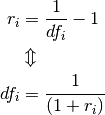
 is the price for borrowing one day at day i from now.
Since prices usually are positive, it means that usually
is the price for borrowing one day at day i from now.
Since prices usually are positive, it means that usually  .
.

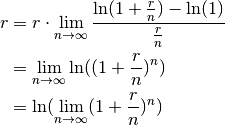
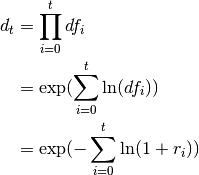
 then
then








 and
and  .
The forward rate is defined as (using no arbitrage):
.
The forward rate is defined as (using no arbitrage):




 .
.



 is interpreted as the level of the curve,
the magnitude of the slope is
is interpreted as the level of the curve,
the magnitude of the slope is  and finally
and finally  is
the magnitude of the curvature.
is
the magnitude of the curvature.  is representing a time rescale.
is representing a time rescale.
 ‘s the code in the
package finance and the rest of this text is based on on the first formula
‘s the code in the
package finance and the rest of this text is based on on the first formula
 so
so  so
so
 is the rate at time 0. Hence
is the rate at time 0. Hence 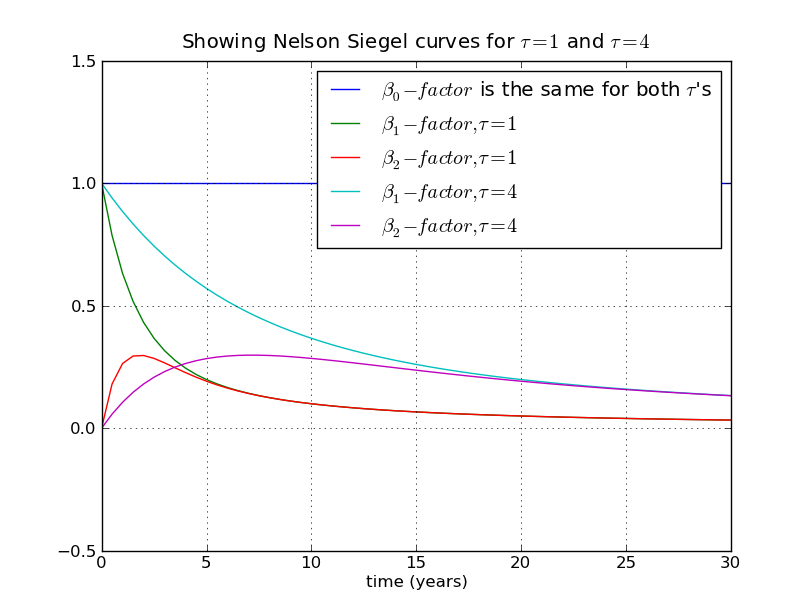
 then the difference between the factors of
then the difference between the factors of  the time has to be greater than 20 before the same
happens.
the time has to be greater than 20 before the same
happens.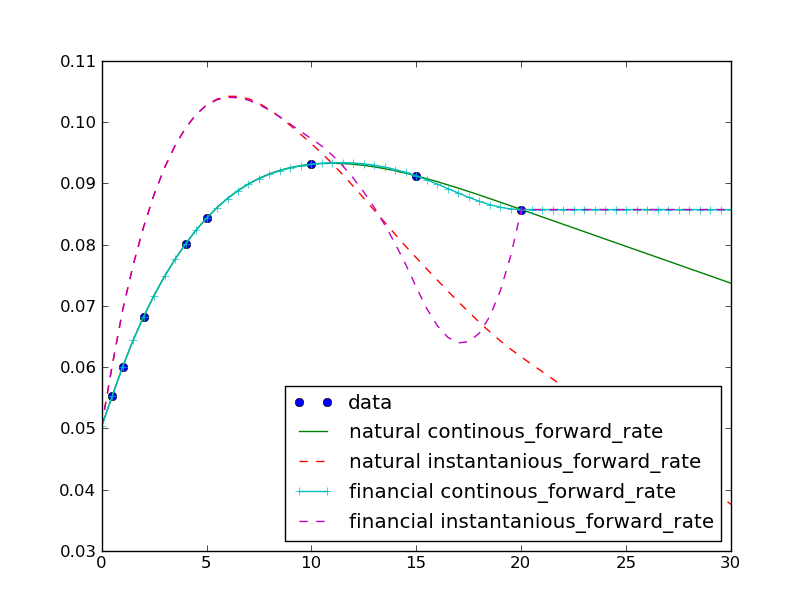
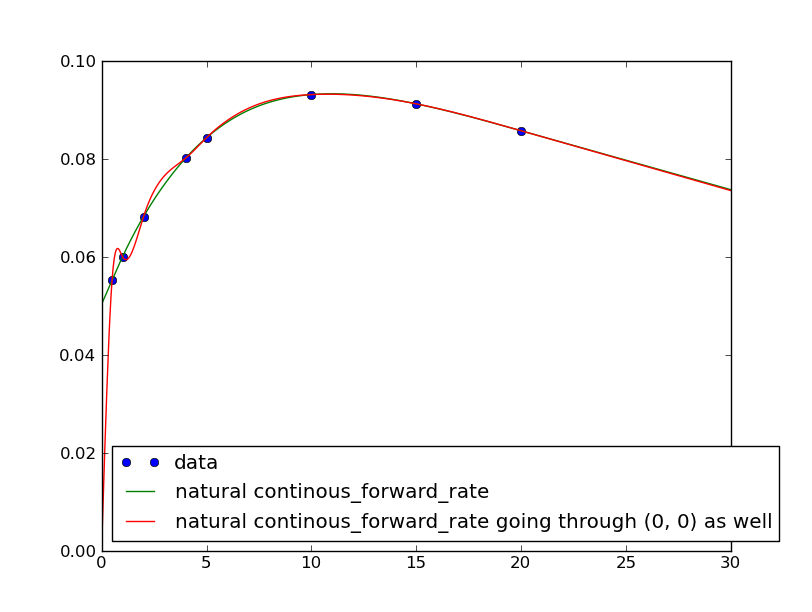
 for all time periods of length 1, it is a flat yield curve and the discount
factors (see
for all time periods of length 1, it is a flat yield curve and the discount
factors (see  .
. at times (dates)
at times (dates)  .
In short this can be written as
.
In short this can be written as  or
or  .
. all has the same value:
all has the same value:
 , eg if a standardized bond is traded.
, eg if a standardized bond is traded. ) equal to a present value (
) equal to a present value (




 is above (below) the sum
of all payments
is above (below) the sum
of all payments  , ie the rate is 0
, ie the rate is 0 , ie the PV function has a
horizontal asymptote
, ie the PV function has a
horizontal asymptote  will always be positive for all
will always be positive for all
 . Note that we are only looking at future times so t is
positive.
Hence the first order derivative of the discount factor is always negative
since:
. Note that we are only looking at future times so t is
positive.
Hence the first order derivative of the discount factor is always negative
since:

 and the PV function is monotone
the last statement is true.
and the PV function is monotone
the last statement is true.
 . Hence
. Hence 
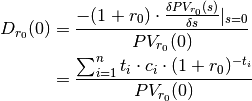
 of the present value
of the present value
 and examine when the future value
and examine when the future value
 is risk free regarding rate
shocks s, ie:
is risk free regarding rate
shocks s, ie:![(\frac{\delta }{\delta s}\left[(1 + r_0 + s)^{t_*} \cdot PV_{r_0}(s)\right])|_{s=0} &= 0 \\
\Updownarrow \\
(\frac{\delta PV_{r_0}(s)}{\delta s} \cdot (1 + r_0 + s)^{t_*} + t_* \cdot (1 + r_0 + s)^{t_* - 1} \cdot PV_{r_0}(s))|_{s=0} &= 0 \\
\Updownarrow \\
(1 + r_0)^{t_* - 1} \cdot (\frac{\delta PV_{r_0}(s)}{\delta s}|_{s=0} \cdot (1 + r_0) + t_* \cdot PV(0)) &= 0 \\
\Downarrow (PV_{r_0}(0) \neq 0)\\
(1 + r_0)^{t_* - 1} \cdot PV_{r_0}(0) \cdot (-D_{r_0}(0) + t_*) &= 0](../_images/math/1a2eb9dc4695b79f8458ef491c8130b3f732922d.png)

 is the present value weighted sum of the durations for
each cashflow, ie:
is the present value weighted sum of the durations for
each cashflow, ie:
 are nonzero.
are nonzero.

 and their sum
and their sum
 are nonzero.
are nonzero.
![PV_{r_0}(s) &\approx PV_{r_0}(0)\left[1 - \frac{D_{r_0}(0)}{1+r_0} \cdot s
+ \frac{1}{2} \cdot \frac{C_{r_0}(0)}{(1+r_0)^2} \cdot s^2
\right] \\
& \Downarrow PV_{r_0}(0) \neq 0 \\
\frac{PV_{r_0}(s)}{PV_{r_0}(0)} - 1 &\approx \frac{-D_{r_0}(0)}{1+r_0} \cdot s
+ \frac{1}{2} \cdot \frac{C_{r_0}(0)}{(1+r_0)^2} \cdot s^2](../_images/math/085f6398e9d6772e223a33c5020a99e4fe1ae70a.png)
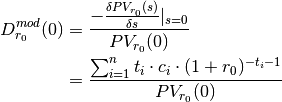

![\ln(PV_{r_0}(s)) &\approx \ln(PV_{r_0}(0)) - D_{r_0}^{mod}(0) \cdot s
+ \frac{C_{r_0}^{mod}(0) - D_{r_0}^{mod}(0)^2}{2} \cdot s^2 \\
& \Downarrow PV_{r_0}(0) \neq 0 \\
PV_{r_0}(s) &\approx PV_{r_0}(0) \cdot \exp \left[ - D_{r_0}^{mod}(0) \cdot s
+ \frac{C_{r_0}^{mod}(0) - D_{r_0}^{mod}(0)^2}{2} \cdot s^2 \right]](../_images/math/14899abd567372295dd3620a74eb1357f81dc390.png)
![PV_{r_0}(s) &\approx PV_{r_0}(0) \cdot \exp \left[ - \frac{D_{r_0}(0)}{1+r_0} \cdot s
+ \frac{C_{r_0}(0) - D_{r_0}(0)^2}{2 \cdot (1+r_0)^2} \cdot s^2 \right]](../_images/math/b0c26ad905874b871496ed90354c4a751f427a1c.png)


 it is
easy to see that the 2 are almost identical (except for the sign).
it is
easy to see that the 2 are almost identical (except for the sign).

 are the continous forward rates at times
are the continous forward rates at times

![PV(s) &= \sum^{n}_{i=1} c_i \cdot e^{-(r_{t_i} + s) \cdot t_i} \\
&= \sum^{n}_{i=1} [c_i \cdot e^{-r_{t_i} \cdot t_i}] \cdot e^{-s \cdot t_i}](../_images/math/61aa8294a6da279919bec7e86e99d6777bdbb91d.png)
![D^{mod}(0) &= \frac{-\frac{\delta PV(s)}{\delta s}|_{s=0}}{PV(0)} \\
&= \frac{\sum^{n}_{i=1}{t_i \cdot [c_i \cdot e^{-r_{t_i} \cdot t_i}]}}{PV(0)}](../_images/math/fabee27262343c9ff0dfc1905346dbf59a8d50ec.png)

 is both the Macauley and the modified durations
(see above).
If no yieldcurve is used to discount then
is both the Macauley and the modified durations
(see above).
If no yieldcurve is used to discount then  is the Macauley
duration where
is the Macauley
duration where 
 is both the Macauley and the modified convexities.
And if no yieldcurve is used to discount then
is both the Macauley and the modified convexities.
And if no yieldcurve is used to discount then  is the Macauley
convexity where
is the Macauley
convexity where